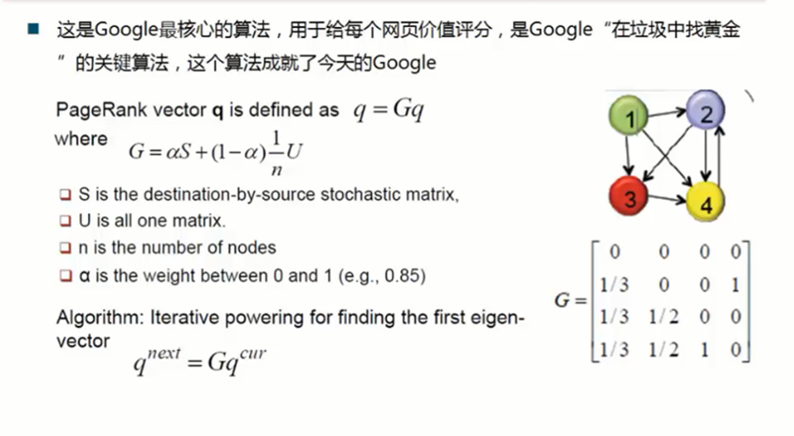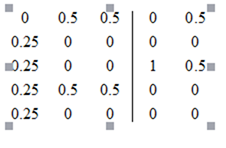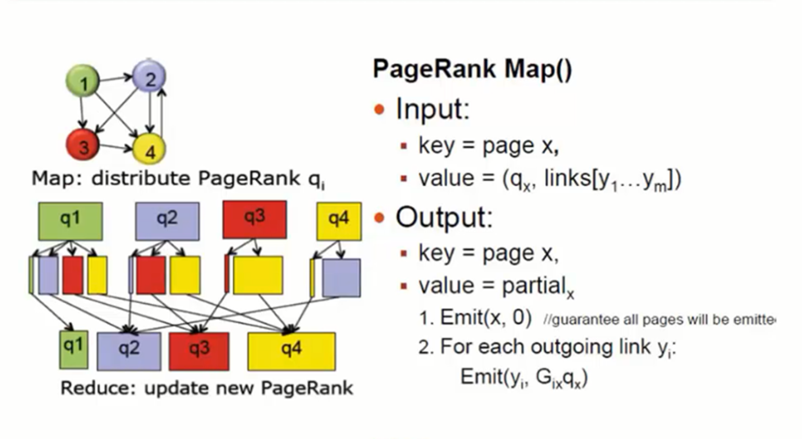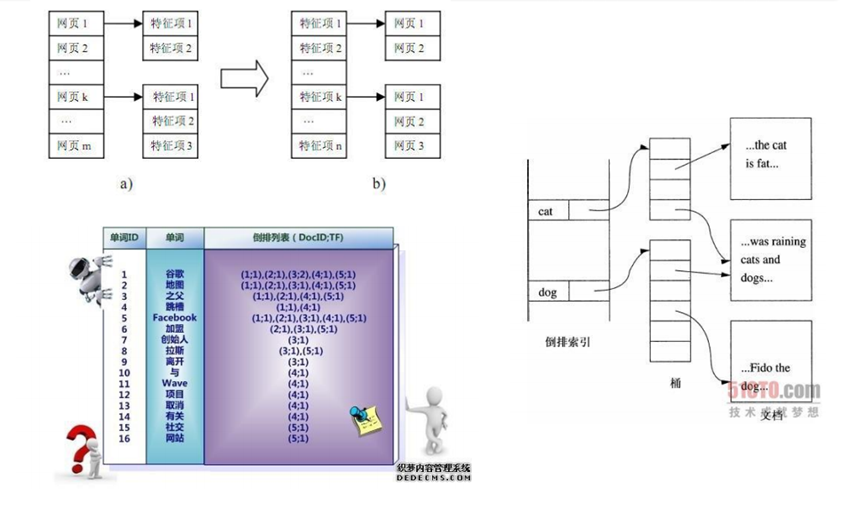Google的PageRank及其Map-reduce应用(日志五)
上一篇:Hadoop的安装(日志四)
1,算法的原理解释:
如下图所示,G就是传说中的谷歌矩阵,这个矩阵是n*n型号的,n表示共计有n个网页。
如矩阵中所示:
11位置处的元素,是表示第一个网页指向的第一个网页的比例值。
12元素,第二个网页指向第一个网页的比例值。
所谓的比例值,这个名称是我给取的,意思就是指向的链接占据所有链接的比例,例如,1网页指向了2,3,4网页,那么其1指向2网页的比例值就为1/3。
按照上面的原理,解析所有的链接,便得到了一个Google矩阵。
Google论文中有:
下面的公式之中α的取值范围是0在1之间任意取值,用于更加方便和精准的计算收敛的q。
至于q=Gq,由于G本身是一个矩阵,所以这个公式其实就是一个线性变换的过程。初始的时候,q可以取任意的值,例如(1,1,1,1,1),但需要注意的是,其维数,一定是要和网页个数相同的。不断对q进行线性变换,最终变换得到的q会收敛于q,而这个就是q表示最终排名的向量。
以上便是上面算法的所有原理解释。
2,例题(及其java实现):
1)A网页有链接指向B,C,D,E
2)B网页有链接指向A,D
3)C网页有链接指向A,D
4)D网页有链接指向C
5)E网页有链接指向A,C
A 请写出这个网页链接结构的Google矩阵
B 手动或编程计算这5个页面的PR值
Google矩阵:
代码实现:这个代码实现,是本人一步步探索出来的,给出的注释比较详细,应该好理解,但其中还所许多需要优化的地方,看上去依旧很low b,请不要见怪哈。
主要原理,就是利用二维数组实现矩阵的运算,搞定了这个,一切就简单。
1 package com.cgtz.main; 2 3 /** 4 * @author Administrator 5 * 6 */public class HelloWorld { 7 public static void main(String[] args) { 8 //原始矩阵 9 double[][] sMatrix=new double[][]{ 10 {0, 0.5, 0.5, 0, 0.5}, 11 {0.25 , 0 , 0 , 0, 0}, 12 {0.25 , 0 , 0 , 1, 0.5}, 13 {0.25 , 0.5, 0.5 ,0 , 0}, 14 {0.25 , 0 , 0 , 0 , 0} 15 }; 16 //单位矩阵 17 double uMatrix[][]=new double[][]{ 18 {1, 0, 0, 0, 0}, 19 {0 , 1 , 0 , 0, 0}, 20 {0 , 0 , 1 , 0, 0}, 21 {0 , 0, 0 ,1 , 0}, 22 {0 , 0 , 0 , 0 , 1} 23 }; 24 double qMatrix[]=new double[]{ 25 1,1,1,1,1 26 }; 27 double gMatrix[][]=new double[5][5]; 28 gMatrix=getGMatrix(sMatrix,uMatrix); 29 printMatrix(gMatrix); 30 double[] lastQMatrix=getLastQMatrix(gMatrix, qMatrix); 31 for (int i = 0; i < lastQMatrix.length; i++) { 32 System.out.println(lastQMatrix[i]); 33 } 34 } 35 //计数,可以调试时使用,也可以用来确定整个迭代的循环进行了多少次 36 static int count=0; 37 //整个方法,就是得出最后的排名向量,是一个核心的方法 38 private static double[] getLastQMatrix(double[][] gMatrix, double[] qMatrix) { 39 //每迭代一次,count的次数就加上一。 40 count+=1; 41 /** 42 创建一个临时的数组,次数组的的长度和需要线性变换的向量的长度相同,此数组可以当成数学中的一个向量。 43 整个temp向量的作用就是用来存放最原始的特征向量,以便与最终的向量进行比较 44 */ 45 double[] temp=new double[qMatrix.length]; 46 // 47 for (int i = 0; i < temp.length; i++) { 48 temp[i]=qMatrix[i]; 49 } 50 System.out.println("temp[1]---1:"+temp[0]); 51 /** 52 下面的嵌套的for循环,是用来q特征向量与G矩阵进行相乘,特征新的向量,需要说明的是,这里其实就是五维空间到五维空间的映射。 53 */ 54 for (int i = 0; i < gMatrix.length; i++) { 55 double newQ=0; 56 for (int j = 0; j < qMatrix.length; j++) { 57 double tempValue=gMatrix[i][j]*qMatrix[j]; 58 System.out.println("tempValue:"+tempValue); 59 newQ+=tempValue; 60 } 61 qMatrix[i]=newQ; 62 System.out.println("----------------"); 63 } 64 //打印出迭代一次之后得到新的排名向量 65 System.out.println("第"+count+"次迭代得到的矩阵。。。"); 66 for (int s = 0; s < temp.length; s++) { 67 System.out.println("qMatrix---"+qMatrix[s]); 68 } 69 /** 70 下面的运算,是求两个向量之间的距离, 71 公式为: 72 73 */ 74 double distace=0; 75 double sDistance=0; 76 System.out.println("temp.length:"+temp.length); 77 System.out.println("temp[1]---2:"+temp[0]); 78 for (int i = 0; i < temp.length; i++) { 79 double x=temp[i]-qMatrix[i]; 80 double x2=java.lang.StrictMath.pow(x,2); 81 sDistance+=x2; 82 } 83 distace=Math.sqrt(sDistance); 84 System.out.println("第"+count+"次迭代sDistance:"+sDistance); 85 //这里自己任意取一个合适的distance来确定多大距离时停止迭代 86 if(distace<0.0001){ 87 for (int i = 0; i < temp.length; i++) { 88 System.out.println(qMatrix[i]); 89 } 90 return qMatrix; 91 }else{ 92 getLastQMatrix(gMatrix,qMatrix); 93 } 94 return qMatrix; 95 } 96 public static void printMatrix(double[][] matrix){ 97 for (int i = 0; i < matrix.length; i++) { 98 for (int j = 0; j < matrix.length; j++) { 99 System.out.print(matrix[i][j]+"--"); 100 } 101 System.out.println(); 102 } 103 } 104 private static double[][] getGMatrix(double[][] sMatrix, double[][] uMatrix) { 105 double gMatrix[][]=new double[5][5]; 106 for(int i=0;i<sMatrix.length;i++){ 107 for(int j=0;j<sMatrix.length;j++){ 108 gMatrix[i][j]=(0.5)*sMatrix[i][j]; 109 } 110 } 111 for(int i=0;i<uMatrix.length;i++){ 112 for(int j=0;j<uMatrix.length;j++){ 113 gMatrix[i][j]+=(0.5)*(0.2)*uMatrix[i][j]; 114 } 115 } 116 return gMatrix; 117 118 } 119 120 121 }
计算的结果:
第14次迭代得到的矩阵。。。
qMatrix—2.8735992663233403E-5
qMatrix—4.620592012663504E-6
qMatrix—3.089895664396781E-5
qMatrix—1.604329405333448E-5
qMatrix—4.620592012663504E-6
由结果可知,c的网页的排名最高。
3,当网页数量较多的时候,就使用分布式计算的方案:
原理见下面的图片:
每个网页乘以对应的分向量,而后变得到了新的q,即为变换之后的q
4,Google的分词技术:










【推荐】国内首个AI IDE,深度理解中文开发场景,立即下载体验Trae
【推荐】编程新体验,更懂你的AI,立即体验豆包MarsCode编程助手
【推荐】抖音旗下AI助手豆包,你的智能百科全书,全免费不限次数
【推荐】轻量又高性能的 SSH 工具 IShell:AI 加持,快人一步